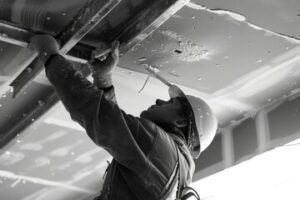Understanding Common Ceiling Issues And Repair Solutions
Ceilings play a significant role in the overall aesthetic and structural integrity of a home or building. However, they are often subject to water damage, cracks, and sagging.
Understanding these issues and how to fix them can help you avoid structural damage and costly repairs. The location and timing of leaks can provide clues as to the source. You should regularly check if you might need Ceiling Repair Perth.
 Cracks
Cracks
Most homeowners will see some cracks in their ceilings over time. Some are cosmetic and not indicative of a larger problem, but others are serious warning signs and must be addressed immediately. Examining the shape, size, and amount of the crack can provide valuable insight into possible causes and solutions.
Hairline cracks in the ceiling are usually caused by temperature and humidity fluctuations that cause plaster to shrink or swell, creating small fissures. While not a major concern, keep track of how thick these cracks get and contact a foundation repair specialist if they grow significantly.
Wider cracks in the ceiling, whether they are straight lines or spiderweb patterns, may indicate structural damage. This could be due to water damage, heavy loads on the floor above the ceiling, or natural settling of the house.
If you notice a long crack that extends from the ceiling to the wall, this is an extremely serious issue and requires immediate professional attention. This indicates that the ceiling is seriously sagging and is not safe to continue supporting heavy loads. The structural damage must be identified and repaired immediately to prevent a ceiling collapse.
If the ceiling cracks are accompanied by a gap between the wall and the ceiling, this is an even more serious problem and must be addressed immediately. This can be caused by truss uplift or excessive weight on the floor above the ceiling. Gaps in the ceiling can be dangerous for both the homeowner and any occupants of the home, especially in high winds.
Cracks in the ceiling that are accompanied by sagging or gaps between walls and the ceiling are indicative of severe structural problems. This could be due to extreme water damage, heavy loads on the floor above, or a weak ceiling structure. A professional inspection of the entire ceiling and its structure should be arranged immediately.
Water Stains
Dark water stains in your ceiling aren’t just unsightly—they’re a warning of serious issues. The building materials that make up your ceiling—including drywall, insulation, and wood—are very absorbent, so the water from a leak can spread quickly and stain large areas of your home. Water damage in the ceiling can also lead to structural damage and microbial growth, so you must take action as soon as you notice any signs of it. Covering a water stain with fresh paint may seem like a quick and easy solution, but it’s important to take the time to clean the spot thoroughly before painting. This will remove mildew, dirt, and other debris that could bleed through your new coat of paint.
It’s also important to find and fix the cause of the water stain before moving on to a repair project. This can be a challenge because the source of the leak isn’t always directly above the stain. For example, a leaky roof may be causing water to seep through the ceiling into the living space below.
If you’re not sure where the water is coming from, a professional can help. They’ll be able to identify the problem and recommend any necessary repairs. They can also help prevent future water stains by providing recommendations for protecting the ceiling from moisture.
If you haven’t done so already, start a monthly check of your ceilings for water stains. This will help you catch the problems early and stop them from spreading before they become more severe. You can also prevent them by installing vents and fans in your home which will help keep humidity levels low and reduce the risk of water damage in the future. If the damage is extensive, you might need to replace the entire ceiling section. If this is the case, you’ll want to consult with a drywall professional. They can repair and install drywall sections that need replacing, and they can also add texture to the ceiling to match its existing condition. They can also replace any light fixtures and electrical boxes that have been damaged by the water.
Sagging
The strength and durability of a ceiling is largely dependent on its supporting structures. If these are inadequately sized or placed too far apart, the weight of the ceiling can become unbalanced and cause it to sag. This can be a serious problem, especially in rooms with high ceilings. It is important to have any sagging in your ceiling examined by a professional. If the sagging is severe, it may be necessary to add support.
Inadequate wall or beam support is another common cause of sagging in ceilings. This can be a result of poor construction, or it could simply be an inevitable part of the building process. This issue is particularly common in suspended ceilings, which have minimal wall support. In these cases, a full building inspection is needed to identify areas that require reinforcement.
A sagging ceiling can also be the result of moisture damage. This can lead to the deterioration of materials that hold the structure together, including the tape used to hold drywall. If the sagging is caused by this type of damage, it’s important to have the entire area inspected and any repairs made as soon as possible to avoid further issues.
Cracks in your ceiling that are accompanied by sagging are often a sign of structural damage and need to be looked at as soon as possible. This type of issue is most likely caused by foundation settlement and should be assessed by a qualified building inspector.
Using the incorrect insulation in your home can also lead to a sagging ceiling. Different types of insulation have a specific load-bearing capacity, and if you’re using a heavier or more dense material than your ceiling was designed for, this can become an issue.
The most obvious sign that you need to have your ceiling inspected is a collapsed or sagging section. A sagging ceiling that is left unchecked can be a serious safety hazard and pose significant damage to your property. Having your ceiling inspected as soon as you notice any signs of problems can save you a lot of money and stress in the long run.
Mold
Mold growth isn’t just unsightly, it can also cause health problems for your family. Thankfully, this is one problem that can often be treated without replacing the entire ceiling.
The first step is to kill the mold. For best results, you should use a mixture of 1 part bleach and 4 parts water in a spray bottle. Apply the solution to the affected spots on your ceiling and allow it to sit for about 10 minutes. Then, scrub the area with a soft brush and rinse it off. Once the spot is clean, you should let it dry completely by opening windows or using a dehumidifier.
If you have a textured ceiling, it is recommended to seek professional help to remove the mold. However, she points out that the most important thing to remember is that mold is a SYMPTOM of a bigger problem. Whether it’s the shower, an ineffective ceiling fan, or a leaking roof, there is a source of moisture that is allowing mold to thrive.
Moisture is the primary catalyst for mold growth, so addressing any water issues promptly should be your priority. In addition to repairing leaks, you should also focus on increasing the amount of heat and ventilation in the room. If possible, invest in a hygrometer to monitor indoor humidity levels and keep them below 50%.
The extent of the mold growth will be easier to identify than you might expect. In cases where the mold is caused by humid conditions or poor insulation, you should be able to see a corresponding cold spot on the opposite side of the wall. This will give you a good idea of the exact location of the mold and allow you to take preventive measures. In other cases, mold will be concentrated in specific areas on the ceiling that are directly exposed to liquid water from a leaking pipe or roof leak. You might not be able to see this directly from the inside of the house, but you should be able to detect it with a thermal imaging camera.



